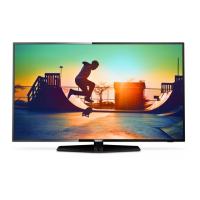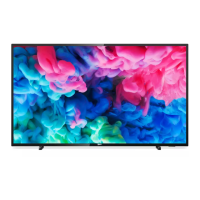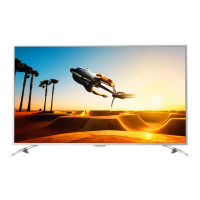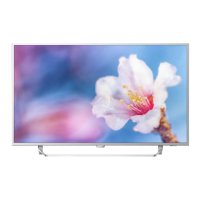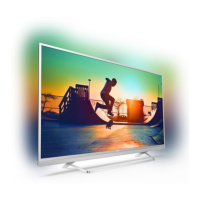Do you have a question about the Philips 43PUS6162 and is the answer not in the manual?
Learn how to find your TV's model and serial numbers for registration.
Access the TV's built-in help and user manual for diagnostics and info.
Find online support, FAQs, and download manuals from the Philips website.
Contact information for customer support and repair services for your TV.
Instructions for updating TV software via Internet, USB, or Over-the-air (OAD).
How to check the current software version installed on your TV.
Guide to using the remote control, including battery replacement and key overview.
Information about the TV's infrared sensor for remote control signals.
Instructions on using the TV's physical joystick for basic operations.
Important safety instructions to read before using the TV.
Guidance on optimal TV placement for viewing and ventilation.
Steps to connect the power cable and turn on the TV for the first time.
Advice on connecting external devices using the best available connection quality.
How to connect an antenna for receiving TV signals.
Instructions for connecting a satellite dish to the TV.
Connecting video devices via HDMI for optimal picture and sound quality.
Connecting audio devices via HDMI ARC and Optical Out for sound output.
Connecting mobile devices via Wi-Fi Direct/Miracast for screen mirroring.
Connecting other devices like CI+ modules and using the Philips TV Remote App.
How to access and navigate the list of connected input sources.
Options to rename connected devices for easier identification in the source list.
Procedure to rescan for and update recently connected devices.
How to watch TV channels, use the channel list, and understand channel icons.
Guide to installing channels via Antenna/Cable, including manual search and settings.
Instructions on using Teletext, selecting pages, and adjusting text settings.
Requirements for using the TV Guide feature, including data sources.
How to open, navigate, and use the TV Guide for programme information and reminders.
How to record digital TV broadcasts, schedule recordings, and manage recorded content.
Using the Pause TV function to pause and resume live broadcasts.
Viewing media files (photos, videos, music) from a connected USB storage device.
How to view photos, start slideshows, and access photo options.
Playing video files from USB, including playback controls and video options.
Playing music files from USB, including playback controls and music options.
Overview of the main menu categories: Channels, Freeview Play, Sources, Utilities, Settings, Demo Me.
Accessing utilities like Smart TV, TV guide, recordings, and software updates.
Accessing frequently used settings and the full settings menu for TV configuration.
Comprehensive guide to all available TV settings, including Picture and Sound.
Settings for USB devices, keyboards, and mice.
Power saving features like energy saving level and auto switch-off.
Enabling control of HDMI CEC devices with the TV remote.
Setting the TV's location mode to Home or Shop for optimal settings.
Configuring shop mode features and demo settings for retail environments.
Options to reset all settings or perform a full TV reinstallation.
Accessing advanced TV settings, including TV Guide configuration.
Options to display or hide channel logos on screen.
Enabling or disabling HbbTV features for interactive TV services.
Managing TV menu language, audio preference, subtitle, and text language.
Features for users with hearing or visual impairments, including audio descriptions.
Setting parental controls, changing codes, and managing CAM PIN for recordings.
Connecting the TV to a home network for internet access and Smart TV capabilities.
Steps for establishing a wireless or wired network connection to the TV.
Viewing network status, configuring static IP, and managing Wi-Fi settings.
Initial setup process for Smart TV, including connection and terms agreement.
Accessing apps, internet, and recommended content from the Smart TV start page.
Browsing and downloading available applications from the Smart TV app gallery.
Using Multi View to display TV channels alongside Smart TV apps or internet content.
Information on the TV's energy efficiency class and consumption ratings.
Detailed technical specifications and energy consumption data for specific TV models.
Guidance on proper disposal of the TV and its batteries according to environmental regulations.
Details on the TV's power requirements, operating conditions, and power consumption.
Technical specifications for TV signal reception, including tuner bands and satellite input.
Information on screen sizes and the TV's native display resolution.
List of video input resolutions and frame rates supported by the TV.
List of computer input resolutions supported by the TV.
Specifications related to the TV's audio output, sound modes, and Dolby/DTS support.
Details on supported connections, file systems, and media playback formats.
List of all available ports and connectivity options on the TV.
General troubleshooting tips and resources for resolving TV issues.
Solutions for common problems related to the TV not switching on or showing startup issues.
Troubleshooting steps for issues where the TV does not respond to the remote control.
Troubleshooting steps for issues related to channel reception and list management.
Solutions for problems with satellite signal detection and channel installation.
Troubleshooting steps for picture quality issues like no picture or distortion.
Troubleshooting steps for no sound or poor sound quality issues.
Troubleshooting HDMI connection issues, including Ultra HD compatibility.
Solutions for problems with USB devices not showing content or causing choppy playback.
Troubleshooting Wi-Fi, internet connection, and network speed issues.
Steps to change the TV menu language back to the correct one.
Comprehensive safety instructions to prevent injury, electric shock, fire, overheating, and damage.
Guidelines for cleaning and maintaining the TV screen to prevent damage.
Trademark information for Mobile High-Definition Link technology.
Trademark information for the DIGITALEUROPE UHD Display Logo.
Trademark information for HDMI and HDMI High-Definition Multimedia Interface.
Licensing information for Dolby audio technologies.
Licensing and trademark information for DTS audio technologies.
Trademark information for Wi-Fi and related logos.
Notice regarding other registered and unregistered trademarks.
Information on the availability of open source software used in the TV and how to obtain it.
Details on the licenses governing the TV's open source software components.
Learn how to find your TV's model and serial numbers for registration.
Access the TV's built-in help and user manual for diagnostics and info.
Find online support, FAQs, and download manuals from the Philips website.
Contact information for customer support and repair services for your TV.
Instructions for updating TV software via Internet, USB, or Over-the-air (OAD).
How to check the current software version installed on your TV.
Guide to using the remote control, including battery replacement and key overview.
Information about the TV's infrared sensor for remote control signals.
Instructions on using the TV's physical joystick for basic operations.
Important safety instructions to read before using the TV.
Guidance on optimal TV placement for viewing and ventilation.
Steps to connect the power cable and turn on the TV for the first time.
Advice on connecting external devices using the best available connection quality.
How to connect an antenna for receiving TV signals.
Instructions for connecting a satellite dish to the TV.
Connecting video devices via HDMI for optimal picture and sound quality.
Connecting audio devices via HDMI ARC and Optical Out for sound output.
Connecting mobile devices via Wi-Fi Direct/Miracast for screen mirroring.
Connecting other devices like CI+ modules and using the Philips TV Remote App.
How to access and navigate the list of connected input sources.
Options to rename connected devices for easier identification in the source list.
Procedure to rescan for and update recently connected devices.
How to watch TV channels, use the channel list, and understand channel icons.
Guide to installing channels via Antenna/Cable, including manual search and settings.
Instructions on using Teletext, selecting pages, and adjusting text settings.
Requirements for using the TV Guide feature, including data sources.
How to open, navigate, and use the TV Guide for programme information and reminders.
How to record digital TV broadcasts, schedule recordings, and manage recorded content.
Using the Pause TV function to pause and resume live broadcasts.
Viewing media files (photos, videos, music) from a connected USB storage device.
How to view photos, start slideshows, and access photo options.
Playing video files from USB, including playback controls and video options.
Playing music files from USB, including playback controls and music options.
Overview of the main menu categories: Channels, Freeview Play, Sources, Utilities, Settings, Demo Me.
Accessing utilities like Smart TV, TV guide, recordings, and software updates.
Accessing frequently used settings and the full settings menu for TV configuration.
Comprehensive guide to all available TV settings, including Picture and Sound.
Settings for USB devices, keyboards, and mice.
Power saving features like energy saving level and auto switch-off.
Enabling control of HDMI CEC devices with the TV remote.
Setting the TV's location mode to Home or Shop for optimal settings.
Configuring shop mode features and demo settings for retail environments.
Options to reset all settings or perform a full TV reinstallation.
Accessing advanced TV settings, including TV Guide configuration.
Options to display or hide channel logos on screen.
Enabling or disabling HbbTV features for interactive TV services.
Managing TV menu language, audio preference, subtitle, and text language.
Features for users with hearing or visual impairments, including audio descriptions.
Setting parental controls, changing codes, and managing CAM PIN for recordings.
Connecting the TV to a home network for internet access and Smart TV capabilities.
Steps for establishing a wireless or wired network connection to the TV.
Viewing network status, configuring static IP, and managing Wi-Fi settings.
Initial setup process for Smart TV, including connection and terms agreement.
Accessing apps, internet, and recommended content from the Smart TV start page.
Browsing and downloading available applications from the Smart TV app gallery.
Using Multi View to display TV channels alongside Smart TV apps or internet content.
Information on the TV's energy efficiency class and consumption ratings.
Detailed technical specifications and energy consumption data for specific TV models.
Guidance on proper disposal of the TV and its batteries according to environmental regulations.
Details on the TV's power requirements, operating conditions, and power consumption.
Technical specifications for TV signal reception, including tuner bands and satellite input.
Information on screen sizes and the TV's native display resolution.
List of video input resolutions and frame rates supported by the TV.
List of computer input resolutions supported by the TV.
Specifications related to the TV's audio output, sound modes, and Dolby/DTS support.
Details on supported connections, file systems, and media playback formats.
List of all available ports and connectivity options on the TV.
General troubleshooting tips and resources for resolving TV issues.
Solutions for common problems related to the TV not switching on or showing startup issues.
Troubleshooting steps for issues where the TV does not respond to the remote control.
Troubleshooting steps for issues related to channel reception and list management.
Solutions for problems with satellite signal detection and channel installation.
Troubleshooting steps for picture quality issues like no picture or distortion.
Troubleshooting steps for no sound or poor sound quality issues.
Troubleshooting HDMI connection issues, including Ultra HD compatibility.
Solutions for problems with USB devices not showing content or causing choppy playback.
Troubleshooting Wi-Fi, internet connection, and network speed issues.
Steps to change the TV menu language back to the correct one.
Comprehensive safety instructions to prevent injury, electric shock, fire, overheating, and damage.
Guidelines for cleaning and maintaining the TV screen to prevent damage.
Trademark information for Mobile High-Definition Link technology.
Trademark information for the DIGITALEUROPE UHD Display Logo.
Trademark information for HDMI and HDMI High-Definition Multimedia Interface.
Licensing information for Dolby audio technologies.
Licensing and trademark information for DTS audio technologies.
Trademark information for Wi-Fi and related logos.
Notice regarding other registered and unregistered trademarks.
Information on the availability of open source software used in the TV and how to obtain it.
Details on the licenses governing the TV's open source software components.
| Screen shape | Flat |
|---|---|
| Response time | - ms |
| Display diagonal | 43 \ |
| Display brightness | 350 cd/m² |
| Display technology | LED |
| Native aspect ratio | 16:9 |
| Peak luminance ratio | 65 % |
| Display diagonal (metric) | 108 cm |
| Screen format adjustments | 16:9, Zoom |
| Supported graphics resolutions | 3840 x 2160 |
| Motion interpolation technology | - |
| RMS rated power | 20 W |
| HDMI ports quantity | 3 |
| Common interface (CI) | No |
| USB 2.0 ports quantity | 2 |
| Common interface Plus (CI+) | Yes |
| Component video (YPbPr/YCbCr) in | 1 |
| AC input voltage | 220 - 240 V |
| AC input frequency | 50 - 60 Hz |
| Power consumption (standby) | 0.3 W |
| Power consumption (typical) | 45 W |
| Package depth | 150 mm |
| Package width | 1150 mm |
| Package height | 680 mm |
| Package weight | 14270 g |
| Product color | Metallic |
| Mercury content | 0 mg |
| Panel mounting interface | 200 x 200 mm |
| Annual energy consumption | 66 kWh |
| Box dimensions (W x D x H) | 1150 x 150 x 680 mm |
| Programming period | 8 day(s) |
| Firmware upgradeable via | Auto upgrade wizard, Network, USB |
| Audio formats supported | AAC, MP3, WAV, WMA, WMA-PRO |
| Image formats supported | BMP, JPG, PNG |
| Video formats supported | AVC, AVI, H.264, H.265, MKV, MPEG1, MPEG2, MPEG4, VC-1, WMV9 |
| Video compression formats | AVC, AVI, H.264, H.265, HEVC, MKV, MPEG1, MPEG2, MPEG4, VC-1, VP9, WMV9 |
| Subtitle formats supported | ASS, SMI, SRT, SUB, TXT |
| Wi-Fi standards | Wi-Fi 4 (802.11n) |
| Tuner type | Analog & digital |
| Analog signal format system | NTSC, PAL, SECAM |
| Digital signal format system | DVB-C, DVB-S, DVB-S2, DVB-T, DVB-T2, DVB-T2 HD |
| Operating temperature (T-T) | 5 - 35 °C |
| Depth (with stand) | 212.06 mm |
|---|---|
| Height (with stand) | 626.4 mm |
| Weight (with stand) | 11220 g |
| Depth (without stand) | 77.3 mm |
| Width (without stand) | 971.3 mm |
| Height (without stand) | 563.53 mm |
| Weight (without stand) | 9180 g |
